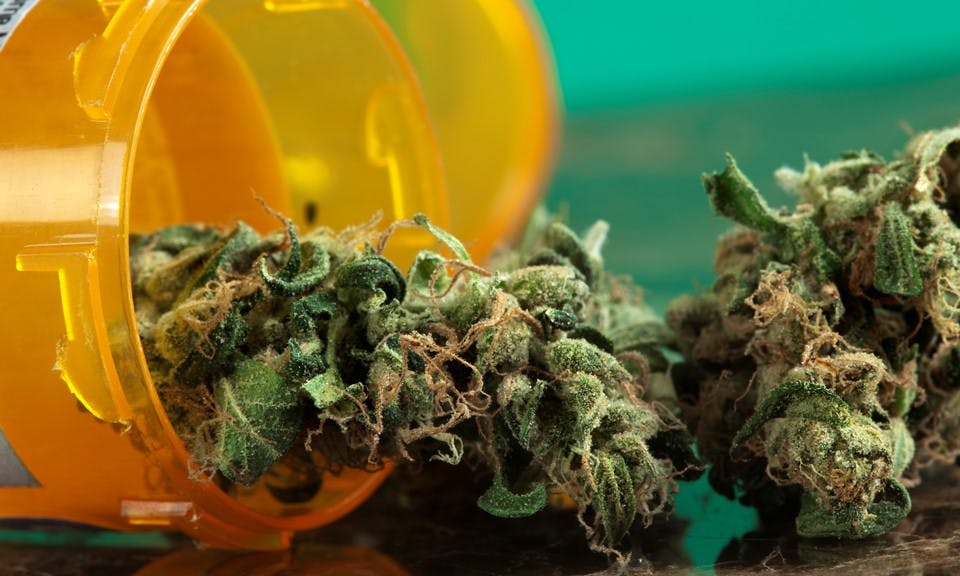Cannabis as a medicine has an ancient history with anecdotes dating back to the Vedic period (c.1500 BCE) in India and Nepal. It wasn’t until 1839 that William Brooke O’Shaughnessy introduced the therapeutic potential of cannabis to the western hemisphere, and another 75 years after that until Sir William Osler, the father of modern medicine, proposed its use for the treatment of migraines and headaches. The criminalization of cannabis has since hindered our ability to research its potential; to-date, much of what we understand is largely anecdotal or based on animal or tissue culture experiments.
However, as countries legalize cannabis and as public opinion changes, cannabis research will flourish. What we already know of its ability to treat migraines and headaches is promising.
What is a Migraine and What are the Symptoms?

A migraine is a complex condition with a number of symptoms including the following:
- Painful headaches
- Disturbed vision
- Sensitivity to light (photophobia) and sound (phonophobia)
- Nausea and vomiting
- Disorientation
- Problems with coordination
These symptoms can last several hours to several days, and in severe cases reversible paralysis or loss of consciousness can occur. Migraines are triggered by a variety of internal (somatic, physiological) and external (chemical, environmental) variables. People who get migraines are thought to have a genetic predisposition toward having abnormal cells in the brain stem.
What Causes Migraines?

Evidence suggests that migraines are the result of a variety of triggers interacting with a dysfunctional brain stem center involved in pain regulation. These triggers activate the trigeminovascular system (neurons in the trigeminal nerve that supply cerebral blood vessels with nerves), and consequently the dilation of cerebral blood vessels, which in turn activate brain circuits associated with pain and inflammation.
Anandamide and 2-arachidonylglycerol (2-AG) are endogenous cannabinoids naturally found in the nervous system that, together with cannabinoid receptors, form the endocannabinoid system (ECS). When anandamide and 2-AG interact with cannabinoid receptors, they inhibit blood vessel dilation and modulate the pain mechanisms activated by an individual’s triggers (e.g. changes in atmospheric pressure, chocolate, or caffeine).
What are the Current Migraine Treatment Options?

Migraines are treated with a variety of acute (onset of an attack) and prophylactic or preventative medications. The frequency and severity of a migraine, as well as the lifestyle and constitution of an individual, are all factors to consider when choosing the proper medication.
Shop highly rated dispensaries near you
Showing you dispensaries nearExamples of acute medications for pain relief (analgesics) include acetaminophen, opioids, triptans, glucocorticoids (steroid hormones), and ergots. In general, preventative medications include a variety of cardiovascular drugs (beta and calcium channel blockers), anti-depressants, anti-convulsants, and non-steroidal anti-inflammatory drugs. Side effects of these medications might include nausea, dizziness, drowsiness, and muscle weakness.
The Mayo Clinic and the Migraine Trust also recommend a variety of complementary therapies including yoga, tai chi, acupuncture, massage therapy, biofeedback, hypnotherapy, cognitive behavior therapy, as well as a selection of herbs, vitamins, and minerals. Not surprising, there is no mention of cannabis as a potentially viable approach to the treatment and prevention of migraines.
Can Cannabis be Used as Migraine Treatment and Prevention?
Pain management is the best known medical benefit of cannabis, most notably of the cannabinoid CBD, which is thought to have analgesic properties that may help reduce a patient’s dependence prescription opiates as well as manage a host of negative side effects. Patients also use cannabis to help them sleep, stimulate their appetite, and manage mood and anxiety levels.
Migraine sufferers can experience debilitating pain, nausea, and vomiting. These symptoms are potentially manageable with cannabis due to the anti-emetic (vomit and nausea-preventing), anti-inflammatory, and pain-relieving properties associated with specific cannabinoids, including THC and CBD.
As with treating any condition with cannabis, there are a number of factors to consider, including confounding ailments, dose, administration and strain, socio-economics, previous experience with cannabis, and the use of other substances such as prescription medication, tobacco, and alcohol. The best thing to do is make an appointment with a family doctor or visit a local cannabis clinic for the best medical advice.
References
- Baron, E.P. 2015. Comprehensive Review of Medical Marijuana, Cannabinoids, and Therapeutic Implications in Migraine and Headache: What a Long Strange Trip It’s Been… American Headache Society.
- Greco, R., V. Gasperi, M. Maccarrone, and C. Tassorelli. 2010. The Endocannabinoid System and Migraine. Experiemental Neurology 224:85-91.
- Greco, R. And C. Tassorelli. 2015. Encocannabinoids and migraines. In Fattore, L. Editor. Cannabinoids in neurological and mental diseases. Cagliari (Italy): Elsevier inc. Pg 173-184.
- The Mayo Clinic








